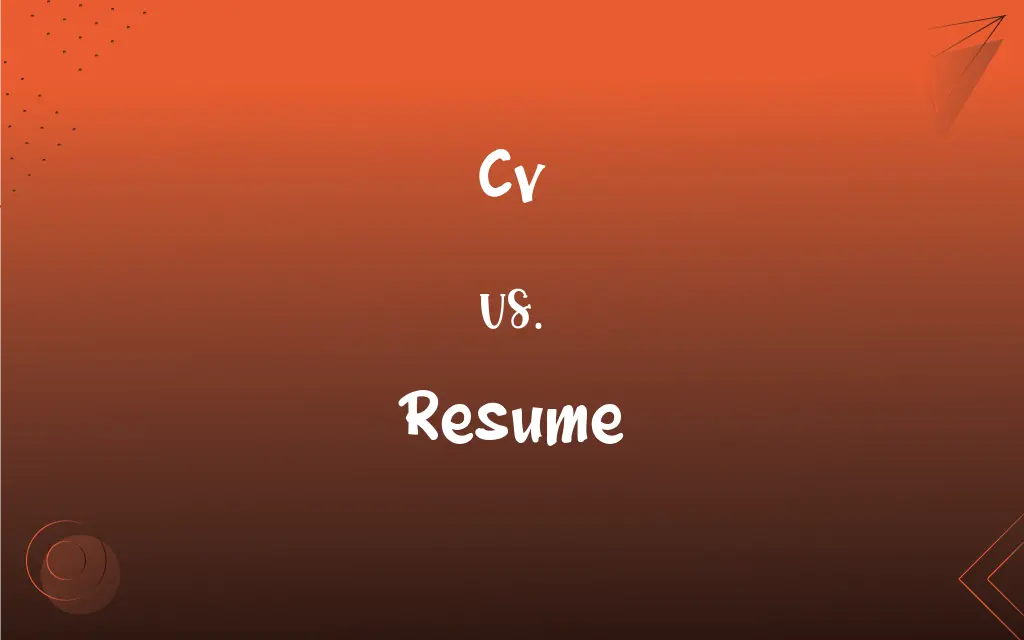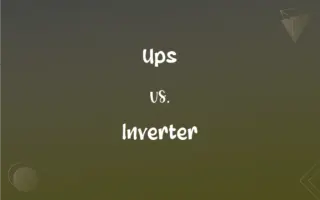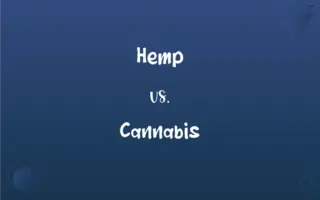CV vs. Resume: What's the Difference?
Edited by Janet White || By Harlon Moss || Updated on October 19, 2023
CV (Curriculum Vitae) is a detailed document highlighting one’s academic and professional history, while a resume is a brief summary of skills, experiences, and education tailored for a specific job position.

Key Differences
A CV, standing for Curriculum Vitae, is an in-depth document that represents an individual's entire academic and professional history. On the other hand, a resume provides a concise snapshot, focusing primarily on work experiences and skills relevant to a particular job position.
CVs typically contain sections detailing education, work experience, publications, awards, scholarships, and more. In contrast, resumes are often tailored to the job at hand, emphasizing the most relevant experiences and skills for that position.
In some countries and professions, a CV is the standard document for job applications. However, in others, especially in the U.S., a resume is more commonly used, especially in the private sector.
The length of a CV can extend multiple pages, covering one's entire career. Meanwhile, a resume is often limited to one or two pages, requiring a concise presentation of the candidate’s qualifications.
Both CV and resume serve as tools for job seekers, but the choice between the two depends on the job, the country, and the industry in which one is applying.
ADVERTISEMENT
Comparison Chart
Definition
A comprehensive document detailing one's academic and professional history.
A concise summary of one’s skills, experiences, and education.
Length
Typically multiple pages.
Usually 1-2 pages.
Content
Covers entire academic and career history, including publications, awards, etc.
Tailored to a specific job, highlighting relevant skills and experiences.
Usage
More common in academic, scientific, or international settings.
Commonly used in the U.S. for private sector job applications.
Customization
Generally remains consistent for different applications.
Tailored and often customized for each specific job application.
ADVERTISEMENT
CV and Resume Definitions
Cv
A comprehensive document highlighting educational background and professional experiences.
His CV lists three published research articles.
Resume
A brief summary of one’s professional and educational history.
She sent her resume to several tech companies in Silicon Valley.
Cv
An abbreviation for Curriculum Vitae, a detailed account of one’s career and qualifications.
She submitted her CV for the teaching position at the university.
Resume
A tailored representation of one’s skills and experiences for a specific job.
She revised her resume to highlight her marketing skills.
Cv
Commonly used in Europe and other parts of the world for job applications.
In the UK, it's more common to submit a CV rather than a resume.
Resume
Typically one to two pages in length, focusing on relevant experience.
Keep your resume short and to the point.
Cv
A tool used mainly in academic and research settings.
Candidates for the post-doctoral position must provide a CV.
Resume
Derived from the French word "résumé", meaning "summary".
The resume gave a quick overview of his professional journey.
Cv
A record of accomplishments, awards, and publications in a field.
The professor's CV is 15 pages long, showcasing his extensive work.
Resume
A document used primarily in the U.S. for job applications.
He updated his resume to apply for the manager position.
Cv
Same as curriculum vitae; - a commonly used initialism.
Resume
A brief account of one's professional or work experience and qualifications, often submitted with an employment application.
Cv
A summary of your academic and work history
Cv
Being five more than one hundred
FAQs
What does CV stand for?
CV stands for "Curriculum Vitae."
How long is a typical resume?
A resume is usually 1-2 pages in length.
Are CVs more common in Europe?
Yes, in many European countries, CVs are the standard for job applications.
Should I list all my jobs on my resume?
Only list jobs relevant to the position you're applying for or those that demonstrate transferable skills.
What's the main purpose of a resume?
A resume aims to present a concise summary of your skills and experiences tailored for a specific job.
How long is a typical CV?
A CV can be multiple pages, depending on one's experiences and achievements.
Should I use a CV or a resume for a job in the U.S.?
In the U.S., resumes are more commonly used, especially for private sector jobs.
Do both CVs and resumes need a cover letter?
While not always required, both can benefit from an accompanying cover letter tailored to the job.
Can I use a CV for a non-academic job?
While possible, it's often better to use a resume for non-academic jobs, especially in the U.S.
Do I always need to customize my resume for each job?
It's recommended, as tailoring your resume can better highlight relevant qualifications for each position.
Can a CV be used internationally?
Yes, CVs are often used for international job applications, especially in academic or research settings.
Are references included in a CV or resume?
References can be included in a CV, while resumes often have a separate reference list or state "references available upon request."
Do I need to include a photo in my CV or resume?
In the U.S., it's generally not recommended due to anti-discrimination laws. However, some countries or professions might expect it.
Is it okay to have gaps in my CV or resume?
Gaps can be okay if they're explainable, such as for education, family reasons, or personal projects.
Is a CV the same as a resume?
No, a CV is a detailed account of one's entire academic and professional history, while a resume is a concise summary tailored for a specific job.
Which format is best for submitting a CV or resume electronically?
PDF is often preferred, as it retains formatting across different devices.
Which is more detailed, a CV or a resume?
A CV is more detailed, covering one's entire career and academic history.
Is it okay to have a 3-page resume?
Generally, it's best to limit resumes to 1-2 pages, but exceptions can be made for extensive experience.
Is "résumé" the correct spelling?
Both "resume" and "résumé" are acceptable, but "resume" is more common in American English.
Can I include hobbies in my CV or resume?
It's common to include hobbies in a CV, but for resumes, only include them if they're relevant to the job.
About Author
Written by
Harlon MossHarlon is a seasoned quality moderator and accomplished content writer for Difference Wiki. An alumnus of the prestigious University of California, he earned his degree in Computer Science. Leveraging his academic background, Harlon brings a meticulous and informed perspective to his work, ensuring content accuracy and excellence.
Edited by
Janet WhiteJanet White has been an esteemed writer and blogger for Difference Wiki. Holding a Master's degree in Science and Medical Journalism from the prestigious Boston University, she has consistently demonstrated her expertise and passion for her field. When she's not immersed in her work, Janet relishes her time exercising, delving into a good book, and cherishing moments with friends and family.































































